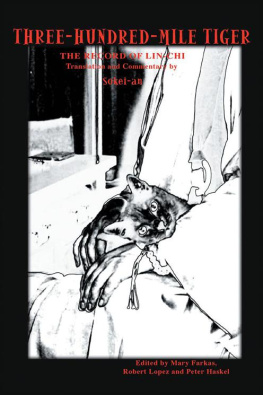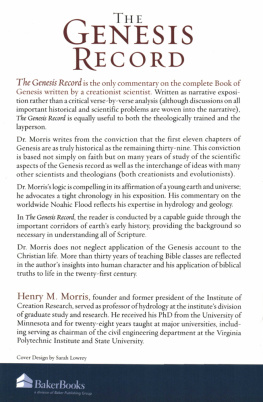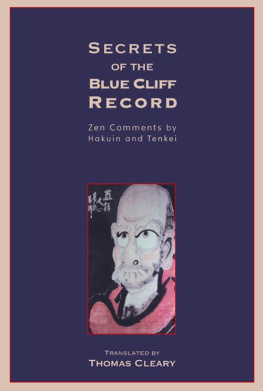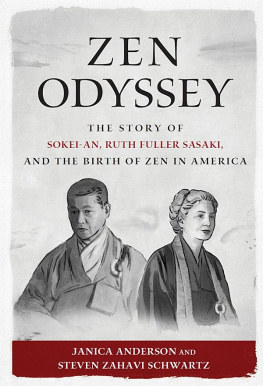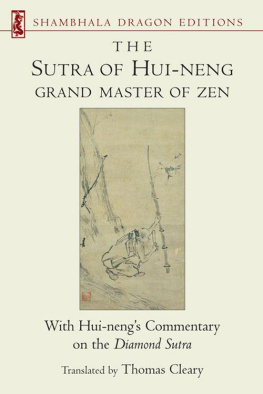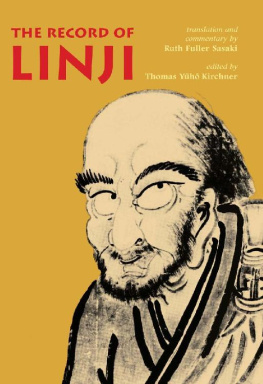THREE-HUNDRED-MILE TIGER
THE RECORD OF LIN-CHI

Translation and Commentary by
Sokei-an Sasaki
Edited by
Mary Farkas, Robert Lopez, Peter Haskel
iUniverse LLC
Bloomington
THREE-HUNDRED-MILE TIGER
THE RECORD OF LIN-CHI Translation and Commentary by Sokei-an
Copyright 2013 by First Zen Institute of America.
All rights reserved. No part of this book may be used or reproduced by any means, graphic, electronic, or mechanical, including photocopying, recording, taping or by any information storage retrieval system without the written permission of the publisher except in the case of brief quotations embodied in critical articles and reviews.
iUniverse books may be ordered through booksellers or by contacting:
iUniverse LLC
1663 Liberty Drive
Bloomington, IN 47403
www.iuniverse.com
1-800-Authors (1-800-288-4677)
Because of the dynamic nature of the Internet, any web addresses or links contained in this book may have changed since publication and may no longer be valid. The views expressed in this work are solely those of the author and do not necessarily reflect the views of the publisher, and the publisher hereby disclaims any responsibility for them.
Any people depicted in stock imagery provided by Thinkstock are models, and such images are being used for illustrative purposes only.
Certain stock imagery Thinkstock.
ISBN: 978-1-4917-0645-9 (sc)
ISBN: 978-1-4917-0646-6 (e)
Library of Congress Control Number: 2013916535
iUniverse rev. date: 11/09/2013
Table of Contents
For the Note-Takers, Audrey and Edna,
And For Mary
Kuei-shan and Yang-shan were disciples of Huai-hai, whose teacher was Ma-tsu, another famous master. Kuei-shan was asking who Lin-chis real teacher was. However, Huang-po (Lin-chis teacher) and Ta-yu were not two men. From this angle, Ta-yu was the head of the tiger and Huang-po its tail. What a huge tiger! Three hundred miles long!
Sokei-an
Shigetsu Sasaki (1882-1945), known as Sokei-an, was the first Zen master to settle permanently in America. Sokei-an studied sculpture and graduated from the Imperial Academy of Art in Tokyo. During this time, he undertook Zen study with the Rinzai Zen master Sokatsu Shaku (1859-1954). Sokatsu, a Dharma heir of the noted Zen master Soyen Shaku (1859-1919), continued Soyens interest in attracting educated lay people to Zen. In 1905, Sokei-an accompanied Sokatsu to California with the mission of building Americas first Zen center. After this mission failed, Sokei-an wandered the American West in a restless search for the American character and the meaning of Zen. He was the original Dharma bum. Settling into Washington Square in 1915, Sokei-an began writing stories about his experiences for Japanese magazines and published four books of humorous essays about America. During the 1920s Sokei-an also supported himself repairing antiques, and returned to Japan several times to complete his formal Zen training. Sokei-an received Dharma transmission from Sokatsu, founding the First Zen Institute of America in New York in 1930. During the next decade Sokei-an offered a mixture of koan study and lectures on Buddhist and Zen texts based on his own translations to a group of dedicated students. The details of Sokei-ans life in his own words can be found in, Holding the Lotus to the Rock (2002).
Sokei-an translated the Record of Lin-chi ( Lin-chi lu ) from 1931 to 1933, in his first series of lectures. He felt that Americans needed original Chinese Zen source materials, translated and commented upon by a Zen master, and there were no such materials in those early days. Sokei-an was the first Zen master to translate the Record of Lin-chi and to give a commentary in English to Western students. The real historic value of Sokei-ans Lin-chi is in his commentary with its manifestation of Lin-chis Zen.
Sokei-ans handwritten translation sits in a weathered box in the FZI publications office. We have reproduced sample pages to illustrate how Sokei-an worked on the text using Chinese, Japanese, and English. Sokei-ans father, a Shinto priest and scholar of medieval Japanese, had taught Sokei-an Chinese from early childhood. Moreover, besides his works in Japanese, Sokei-an wrote short stories and poems in English. Although he spoke with a strong accent, Sokei-an prided himself on finding the right English equivalents as he translated Buddhist terms. Sokei-an had studied the Lin-chi with his Zen master, Sokatsu, and had finished the Zen koans that relate to passages of the text. These experiences had prepared him as each week he sat at his desk with his unabridged Websters dictionary, his large map of Chinese Zen sites, and his Chinese- and Japanese-language Tripitaka texts, translating and preparing his commentary. Chaka, Sokei-ans cat sat contentedly on his lap assisting. This is Chaka on the cover of Three-Hundred-Mile Tiger.
What makes Sokei-ans commentary so enjoyable is his ironic wit and his dramatic recounting of his vivid experiences in Japan and America as a young Zen student. Manifesting Lin-chis Zen before the eyes of those lucky enough to come to his little temple on West 70 th Street in 1930s New York, Sokei-an apparently also liked to act out the dramatic parts of the texts encounters.
In November 1941, disatisfied with his original, Sokei-an began a second series of translations and commentaries on the Lin-chi. Shortly before Japan attacked Pearl Harbor in 1941, the institute moved into the home of Ruth Fuller, a Chicago heiress and longtime Zen practitioner, who had joined the group in 1938. Following the outbreak of the Pacific War, Sokei-an was interned at Ellis Island as an enemy alien and was later sent to a camp in Fort Meade, Maryland. Sokei-an had completed only twenty-seven of the new commentaries, assisted by Ruth. He was released in 1943, subsequently married Ruth Fuller, and resumed teaching and giving sanzen (private zen interveiws) until his death in 1945.
Ruth Sasaki, then vice president of the First Zen Institute of America, had intended to publish Sokei-ans Lin-chi after his death. The 1932-33 commentary and the original translation however, existed only in the notes of Sokei-ans original students. After starting the First Zen Institute of America in Japan, and conferring with Japanese and American experts in Zen and early Chinese texts, Ruth decided to launch upon a more accurate translation for use by Western students using Sokei-ans second translation as a first draft. The excellent version edited by Ruth Sasaki is now available with the notes and a fine introduction in the edition edited by Thomas Kirchner (Kyoto: 2009). Only a Zen master, however, may comment on the Zen meaning of this material. As Sokei-an stated: When other teachers of Zen come after me to this country, they should note what I have just said about transmitting Zen to American people. They should not transmit that particular poetic feeling that comes from Chinese sentences. I am trying to transmit Zen itself to American people, not Chinese literature.
Back in New York, Sokei-ans commentary, which had been given orally, was gradually rescued from the notebooks of his students by Mary Farkas, who had also joined the institute in 1938 and served as secretary of the First Zen Institute until her death in 1993. Sokei-ans lectures and translations from 1932-33 were painstakingly collated and edited by her over the 1960s and 70s. This is the version presented here. Mary was then editor of the Institutes periodical, Zen Notes, and it was there that she first published the Lin-chi in installments. Mary laughed to herself as she put together each new installment of Sokei-ans Lin-chi, and we would receive animated demonstrations and exclamations from her about the stories in the text. She was loathe to explain Lin-chis actions, but wanted us to grab hold of the mighty principle. When Mary was asked why we needed this awakening of mind, she simply answered, Well, thats what a human being is.
Next page
